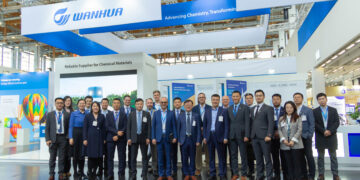Wanhua Chemical Group Nutrition Technology Co., Ltd. launches 10,000 t/a Vitamin A production facility in Yantai Huang-Bohai New Area in mid-March 2025. It is a part of the master project of citral production, integrating the production of both upstream intermediates and downstream end products, covering high-value sectors including vitamins, fragrances, and feed additives.
Project Scope Includes:
- Basic Chemicals:
- 124,000 t/a prenol
- 30,000 t/a 3-Methyl-2-butenal
- 48,000 t/a citral
- Fragrance Ingredients:
- 15,000 t/a citronellol
- 10,000 t/a geraniol
- 1,000 t/a menthol
- Vitamin A Line:
- 10,000 t/a violetone (intermediate)
- 10,000 t/a Vitamin A (500,000 IU/g)
- Vitamin E Line:
- 18,000 t/a linalool (intermediate)
- 20,000 t/a crude VE
- 40,000 t/a Vitamin E (50 % powder)
Strategic Disruption in a Fragile Global Market
This launch comes at a time when the global Vitamin A market remains deeply unstable. Currently, about 60% of global VA production capacity is concentrated in the hands of just a few players, notably BASF and DSM. BASF alone holds a capacity of 14,400 tons/year, accounting for 27% of the global total.
This monopolistic structure came under severe scrutiny in July 2024, when a massive explosion at BASF’s Ludwigshafen plant disrupted the supply of aroma chemicals and vitamin precursors. In just two days, Vitamin A prices in China soared by 53%, while Vitamin E jumped 20%—a stark reminder of the risks posed by foreign supply dependence.

A Turning Point for China’s Vitamin Industry
Wanhua’s successful ramp-up of its 10,000 t/a Vitamin A facility is a pivotal moment in China’s drive for industrial self-reliance. By securing the No. 2 spot in global VA production, Wanhua is not only breaking a longstanding international monopoly but also offering a stable, domestic alternative that could reshape global pricing dynamics.
More importantly, this project demonstrates the power of vertical integration paired with deep process innovation. From raw materials to end products, Wanhua’s model ensures cost control, supply chain resilience, and environmental responsibility—hallmarks of the next-generation chemical industry.












